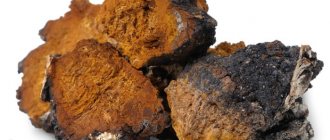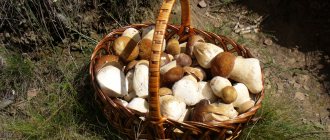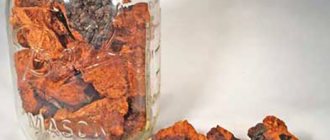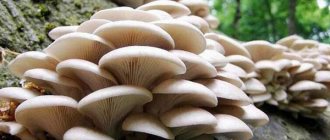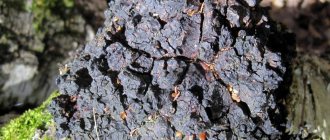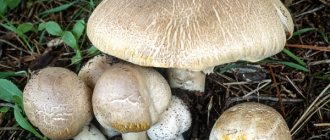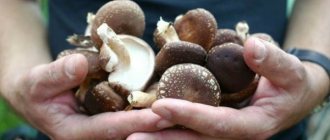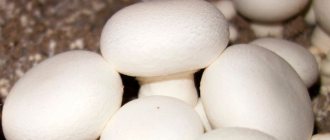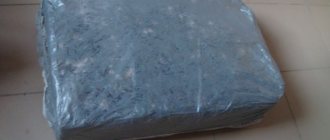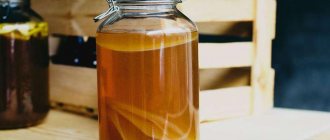AnyutaN — Jan 9th, 2022 Category: Dried mushrooms
Tags: Dried chaga
Chaga (birch mushroom) are small growths on deciduous trees. You can find mushrooms on trees such as alder, maple or rowan, but only birch chaga has unique medicinal properties. The benefits of these growths are undeniable. Since ancient times, they have been used by traditional healers to treat various diseases, including malignant neoplasms. Also, tinctures, decoctions, or simply brewed into tea are prepared from chaga. We’ll talk about how to properly collect and dry chaga for the winter in this article.
Ingredients: chaga Time to add: All year
Features of harvesting chaga mushroom
Before harvesting the mushroom, first of all, you need to decide on the collection time. Theoretically, you can cut chaga throughout the year, but in practice this is usually done in spring or autumn:
- In the autumn and spring, birch growths contain the most medicinal substances, and accordingly, harvesting is most justified.
- Harvesting mushrooms in winter is more difficult due to frost and snowdrifts. Snow drifts make it difficult to get close to the tree, and the mushroom itself is much harder than in the warm season and requires great effort to harvest. It also takes longer to dry winter birch growths during harvesting.
- In summer you can get close to the birch trunk without any problems, but another difficulty arises. Dense tree foliage often hides growths on birch trunks, making them more difficult to see.
Traditionally, people go to the autumn forest for birch tinder fungi during the period of active leaf fall, when the trees are exposed and it becomes easier to find the growths. Mushroom harvesting can also be carried out in March-April, after the main snow melts, but before the leaves bloom.
Chaga growths located high above the ground need to be cut off.
Processing and storage
After the chaga is separated from the trunk, it must be processed right there, in nature, in a birch grove, leaving the unusable parts of the fungus, birch sawdust, and debris in the same place where it was cut. The process of processing mushrooms is not so much labor-intensive as it is painstaking. Chaga is divided into parts: those that are darker and those that are lighter in color. Light, loose chaga, as well as parts of it that have the same color, do not have the necessary medicinal properties, they do not contain the necessary biologically active additives, and they are not used in folk medicine. Once the chaga is divided into parts based on color, the hard and dark components of the mushroom are processed so that the chaga can be stored further, after thoroughly drying the mushroom.
How to properly store chaga and how long can it be stored? Quite a controversial issue. Those who have been collecting chaga for a long time have, of course, their secrets. Some even claim that chaga can be stored for many years without losing its unique properties. But any biological substances have their own shelf life when they have certain qualities. The approximate shelf life of the mushroom is about two years. This is how long chaga does not lose its unique medicinal properties and it contains biologically active substances that are necessary for the preparation of medicines.
How to prepare chaga correctly
Harvesting is a fairly simple process, but when carrying out it you need to take into account several rules:
- Mown tinder fungus should only be collected from living trees; a mushroom located on fallen trunks or stumps does not have any special valuable properties.
- For harvesting, you need to cut off the mushrooms located in the upper part of the tree; it is better not to touch the growths near the ground, their medicinal value is minimal. Useful birch chaga should be located at a distance of at least a meter from the ground, and preferably higher.
- The most useful are birch tinder fungi, which are located in a group on one tree.
- The growth is difficult to separate from the birch trunk. It must be cut down using a small hatchet or a very sharp wide knife. The incision is made vertically, ideally it should run parallel to the tree trunk and separate the tinder fungus from the birch tree right at the place where the fungus connects to the trunk.
Attention! When harvesting, woody growths are cut off exclusively from birch trees; tinder fungi on other trees do not have any beneficial properties. In addition, birch chaga should not be confused with ordinary tinder fungus pests; they can be distinguished by their light shade and pronounced hoof-shaped cap.
The chaga growth is separated from the trunk with a vertical incision
Answers to frequently asked questions
Where does chaga grow in Russia?
The highest export rates are shown by the following regions: Primorsky Krai, Moscow and Chita region (2/3 of the total export volume). Chaga grows in the Altai and Krasnoyarsk territories, in the Novosibirsk and Irkutsk regions. The population of these areas is engaged in collecting for subsequent delivery to large importers. These mushrooms can be found at a height of 5 meters from the ground, mainly in swampy areas and northern latitudes.
How much can you earn from collecting chaga?
If you collect 100 kg of chaga per day in 3 months of intensive collection, you can earn more than 500,000 rubles.
What are the benefits of chaga?
Its use actively helps in the fight against many types of diseases. Helps treat cancer, diabetes, stomach diseases, infections, psoriasis and dozens of other diseases. The decision to use the “birch mushroom” in medicine was made at the beginning of the 19th century, and this mushroom has been known in old signs and sayings for a long time. Chaga strengthens the immune system, increases mental activity and tone. Thanks to its healing properties, the body will receive a whole range of useful components.
Why do you need to dry chaga?
The medicinal properties of chaga are due to the content of the following substances: melanin, batulin, sterols, carboxylic acids, phenols, amino acids, flavonoids, micro- and macroelements. In cut mushrooms, enzymatic and oxidative reactions are accelerated. Chaga quickly loses its beneficial substances, darkens and can become moldy.
Does such a business need to be licensed?
To extract for the purpose of exporting abroad, you must obtain the following documents: permission from Rosprirodnadzor and a license for the export of chaga from the Ministry of Industry and Trade of the Russian Federation. You will also need a certificate of origin for chaga.
How to Process Chaga
Immediately upon returning from the forest, you must properly clean the chaga at home. If you do not plan to use birch tinder fungus immediately, then the treatment is as follows:
- the growth is beaten off with a sharp knife and cleared of loose areas of light color - in the place where it came into contact with the tree;
- Using a wide, strong knife or a small hatchet, the lumpy black bark covering the top of the mushroom is broken off from the growth;
- the remaining brown solid part is cut into small pieces of 3-5 cm in diameter; it is most convenient to store the tinder fungus in this form.
After processing, the birch tinder fungus needs to be dried for harvesting. This can be done in several ways; which one to choose depends on the purpose for which the dry product is needed.
Description
Chaga (Inonotus obliquus), also known as black birch fungus or tinder fungus, belongs to the Hymenocheteaceae family of the Agaricomycetes class. Its life cycle reaches 20 years, and the birch tree on which the fungus settles inevitably dies
Pay special attention to what chaga looks like in the photo below.
- Outwardly, it is a black, cracked growth of irregular shape on the surface, tending to be round. It is deeply embedded in the wood;
- The pulp is hard and woody. The deep layer is dark brown, close to the trunk is lighter, reddish-brown;
- hyphae are colorless. Their light veins densely penetrate the flesh at the base;
- has the following characteristics: dimensions – up to 50 cm in diameter, thickness – up to 20 cm, weight – up to 2 kg.
At this stage of development, the chaga mushroom has renowned medicinal properties.
How to make a drying chamber for chaga
If the harvesting of beveled tinder fungus is carried out in large volumes, then it is most practical to build a dryer for chaga at the dacha or in the house. It's quite simple to do this:
- The main thing you need to create a drying chamber is a small room in which there is a stove, fireplace or electric oven.
- The room will need to install a high-quality door that prevents drafts from entering. If there are windows in the chamber, it is necessary to install sealed double-glazed windows that do not allow air to pass through when closed.
- All cracks, cracks and other openings in the walls and corners must be sealed with sealant, and the walls themselves must be covered with insulation, which will help maintain a stable temperature. You can line the room with brick from the inside; it will help retain the heat coming from the fireplace or stove.
At the last stage, you will need to build metal shelves in the room on which the workpieces will be placed.
Harvesting in a drying chamber is very simple - the processed tinder fungus is placed in large volumes in a room, the oven is heated and an even temperature is maintained over the next few days for uniform drying.
To dry chaga raw materials, you can equip a special dryer
Advice! If warm air does not circulate well in the room, you can install a fan.
If the volume of workpieces is very large, you can also build a spacious dryer on the site, the size of which is more reminiscent of a garage. For it you will need to lay a foundation, then assemble a frame from an aluminum profile and metal sheets, and install thermal and waterproofing. Drying is carried out using a heat gun.
A large dryer helps quickly process large volumes of raw materials. However, its construction is profitable only if there is a business based on the sale of birch tinder fungus in wholesale quantities.
How to dry chaga at home
If birch chaga is harvested for personal purposes and in small quantities, then specially equipped dryers will not be needed. It is better to dry the mowed tinder fungus under normal conditions - this can be done in several ways:
- Natural drying. The process takes a lot of time, but more useful substances are preserved during this preparation - the valuable compounds in the mushroom are not destroyed. For natural drying, wood growth, chopped into small pieces, is laid out on sheets of thick paper and placed in a dry and well-ventilated place. The correct way to dry birch chaga is in the shade, away from the direct rays of the sun; in summer, verandas or tables under awnings are suitable, and in winter, shaded window sills are suitable. If the conditions are met, the mushroom will dry completely in 2-3 weeks.
- In the oven. This method is faster, although some of the beneficial substances in the composition are lost when used. Chaga raw materials should be laid out on a baking sheet or wire rack, and then placed in an oven heated to just 50 °C. The door must be left open for the entire drying time, and the process takes 8-10 hours.
The raw materials can also be dried using a special electric dryer. In this case, you will need to set the device temperature to no more than 40 °C and place birch tinder fungus in special trays for 7-8 hours in the dryer. From time to time it is recommended to move the trays from place to place so that drying occurs more evenly.
For private use, it is more practical to dry chaga in the fresh air or in the oven.
Tips and recommendations for storage and use
Here are some useful tips on how to properly store birch mushroom:
Before drying, it is necessary to remove dust and birch bark from the product. The product should not be prepared in large quantities, as over time it loses its healing properties. It is important to remember that unsuitable utensil material reduces the shelf life of the mushroom. It is not recommended to procure raw materials purchased in stores or from hand, since it is not known in which places they were collected. It is not necessary to chop or cut the mushroom into pieces - you can store it whole, but this will require much more time. You can divide the raw materials into parts by any means - with a knife, an ax, passing through a meat grinder, etc. When preparing for storage, you should not throw away the black peel, since this part can be used for medicinal purposes. Do not dry raw materials in the oven. Many people are interested in the question of whether it is possible to pour boiling water over a mushroom; Chaga can be brewed at 100 degrees - even under such conditions, the beneficial qualities of the product will be preserved (the mushroom must be infused for 20 minutes - you will get a real medicinal infusion). The tinder fungus can be infused not only in boiling water, but also in vodka (the powder obtained from the dried mushroom is placed in vodka and kept for 2-3 weeks). Containers for workpieces should not be airtight - constant air circulation is required. Dried product should not be stored in the refrigerator. It is necessary that the containers with chaga are located in a dark, dry place and not exposed to direct sunlight and moisture
If chaga gets damp, it will quickly become moldy. The raw materials must be dried immediately after collection, and cut or crushed immediately after drying, before the product hardens too much.
How to properly store chaga
If the raw material is not intended to be used immediately after harvesting, it should be stored. Dried raw materials must be kept in paper bags, cardboard boxes or wooden containers. It is important to note that the container cannot be hermetically sealed with a lid; air must be allowed in, otherwise the mushroom will lose its beneficial properties.
For storage, birch tinder fungus is placed in a dark place with low humidity. At room temperature, the mushroom feels quite comfortable, but there is no need to put it in the refrigerator.
Storage containers
Containers for storing dried product must be clean and dry. Fresh mushrooms are easily affected by mold, so they must be dried.
In order for chaga to retain its properties, you need to use the following containers:
- glass jars with mesh lids;
- paper bags;
- linen bags;
- carton boxes.
The product should not be prepared in large quantities, since the healing properties are retained only for 4 months. Herbalists do not recommend using plastic containers. The wrong choice of cookware reduces the shelf life of raw materials.
Shelf life of chaga
The shelf life of chaga after harvesting depends on the processing method. Dried raw materials are stored longer - this is another reason why drying is recommended immediately upon returning from the forest.
Chaga raw materials retain valuable properties after drying for 2 years
How long does dry chaga last?
Dry birch tinder fungus can retain valuable properties for 2 years. But how long chaga can be stored in dry form depends on compliance with storage rules. Therefore, you need to carefully monitor the conditions; low humidity is required; the harvested mushroom must “breathe” fresh air. The appearance of dampness in the container is unacceptable; under such conditions, mold will quickly develop on the mushroom.
Important! It should be noted that after 2 years, birch growth does not become toxic, provided that it was stored correctly. It simply loses valuable properties and causes neither harm nor benefit.
How long does fresh chaga last?
The shelf life of fresh raw materials is much shorter - only about 3-4 months. That is why it is recommended to process the mushroom and dry it as quickly as possible. If you leave fresh tinder fungus in a place with unsuitable temperature and humidity, it can become moldy and lose its beneficial properties.
It is also recommended to process raw materials quickly because over time, the hard bark on the surface of the growth becomes more rigid. Cleaning a stale mushroom will be more difficult and the process will take longer.
Fresh chaga raw materials are not stored for long - only a few months
Jars and bags are the best storage containers
Before storing chaga, it is chopped into small pieces and dried thoroughly. Chaga can easily suffer from mold, so it should not be dried and stored in a damp room with poor ventilation, where there are changes in temperature and humidity. Bright sunlight is also not a suitable option for storing mushrooms. Chaga loses its beneficial substances when dried in the oven or if it is stored in a room where the temperature is high. That is why experts recommend storing chaga in a dry room, where there is no dampness that is dangerous for it, but there is good ventilation. That is, chaga needs a storage environment that is commonly called the “golden mean”.
Chaga is well dried and stored when it is cut into small pieces no more than six, but no less than three centimeters long. No less important is the issue of optimal, competent selection of containers where they are stored. Medicinal mushrooms are not stored in plastic or iron containers, but glass jars with tight lids will be just right for it. Chaga can also be stored well in linen or paper bags, but in them the mushroom is more vulnerable to the slightest temperature changes and changes in room humidity.
Chaga processing plant
Before placing chaga in jars or bags, check its readiness for subsequent storage. If the mushroom becomes hard after drying and does not crumble, then it can be placed in storage containers. Chaga can be stored for its term without losing its medicinal properties if the jar or bag in which it is placed is in a dark, dry place, protected from light.
When storing it, it is necessary to observe the same precautions as in the case of medicines manufactured in pharmaceutical production
Harvesting birch chaga as a business
The medicinal properties of chaga are recognized not only by folk medicine, but also by official medicine and homeopathy. Therefore, chaga raw materials are in great demand on the Russian and foreign markets. Every year Russia sells more than 1 million kg of birch chaga, with China and Korea being the main buyers. Birch tinder fungus is also in demand within the country, which makes it possible to create a profitable and interesting business based on the harvesting of birch growths:
- To create a successful business, you will first need to resolve the issue of procuring raw materials. Depending on the scale of the business, it is necessary to either find a sufficient number of mowed tinder fungi close to home, or acquire reliable suppliers.
- To develop your business, you will also need to equip a spacious dryer in your dacha or country house, or several at once if the business develops well. Drying birch mushroom using home methods is unprofitable; if the raw material is intended for sale, the process will go too slowly.
- Before starting a business, it is recommended to find regular wholesale buyers for raw materials in advance. This is also rarely accompanied by difficulties - both Russian buyers and clients from China and Korea are interested in chaga.
The business of procuring and selling chaga is quite profitable and allows you to receive about several hundred rubles in profit every month.
If you wish, you can sell chaga in retail quantities, for example, through appropriate forums on the Internet. The profit from such a business will be low, but retail sales will allow you to get rid of excess chaga and also receive a nice cash bonus.
Chaga procurement business can be very profitable
Cost formation
The total value of collected chaga per year is more than $8,000,000. More than three-quarters of the drug's exports come from China. Second place with a modest indicator of 13.6% is occupied by the Republic of Korea.
The cost of 1 kilogram of export raw materials is different in all regions of Russia, it is in the range of 40-70 rubles. The amount also depends on the quality of chaga processing; purified raw materials will be sold at a higher price. The wholesale price of birch chaga for export ranges from 4–6 dollars per kilogram. The price depends on several conditions; for an accurate calculation, you need to draw up a specific business plan. The cost of purchasing chaga in Russian pharmacies is 60 rubles per 70 grams.
